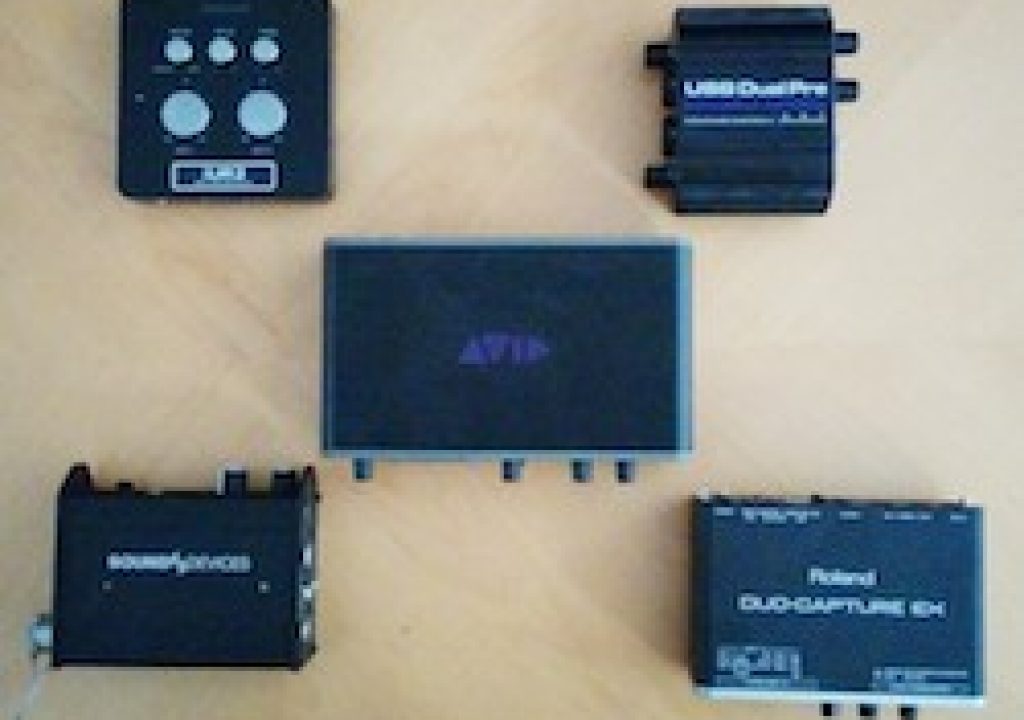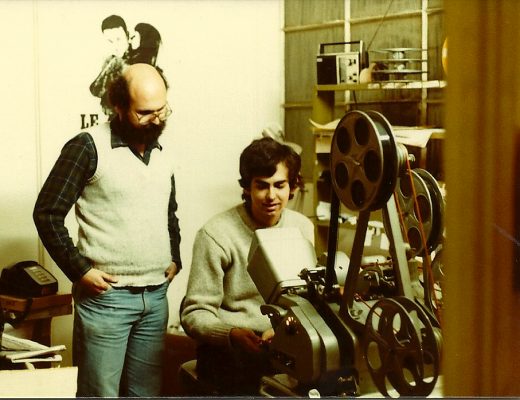In prior articles, we have established that the best audio quality on iOS devices is achieved when connecting digitally, thus bypassing their inferior preamp and internal A>D converters. We have also discovered that starting with iOS 7, iPhones and iPod Touches can now join the digital party, together with iPads. It’s easy to connect a single (compatible) USB mic to your iDevice, but what about connecting two mics digitally? In this article, I’ll compare devices from ART, Avid, Roland, SoundDevices, and Tascam, between US$79 and US$899, from specs/features to actual recording samples.
Why I test preamps with a dynamic microphone
I prefer to test preamps and A-to-D converters with a good dynamic microphone to make them work harder, knowing that if they can work well with a dynamic mic, they can easily also work with a condenser microphone. Generally speaking, dynamic microphones by nature have a lower output level than condenser microphones (which require electrical power and generally have a higher output level). Dynamic microphones are also the standard of the industry for ENG (Electronic News Gathering) handheld interviews. All of the preamps in all of the tested outboard interfaces tested below offer phantom power (primarily for condenser mics). However, I made sure that the phantom power was off (inactive) in all cases since the same cardioid dynamic hybrid microphone I used for all of the tests does not require it.
Frequent readers know, I call the Audio Technica AT2005USB hybrid because it has both analog balanced XLR output, as well as digital USB, which uses its own internal preamp and A-to-D (analog to digital) converter.
Speaking of electrical power…
By nature, all audio preamps and A>D converters need to get electrical power from somewhere. Some get it from the USB bus (i.e. the same connection where they communicate their audio signals), some get it from a separate USB connection, some get it from internal batteries, and some get if from a specific external power port. I will comment about the electrical power requirement of each device tested in its respective section of this article. For a “studio” (i.e. fixed) situation, having to use external power is acceptable. For mobile use (i.e. when you are counting on your iPad, iPhone or iPod Touch to run on its own battery while you record), it is a pain to have to use external power to run an external audio interface, so that may cause some people to prefer one that doesn’t require it, especially if they plan to do a lot of mobile recording with their iOS device.
5 external audio devices, plus 1, for a total of 6 tests
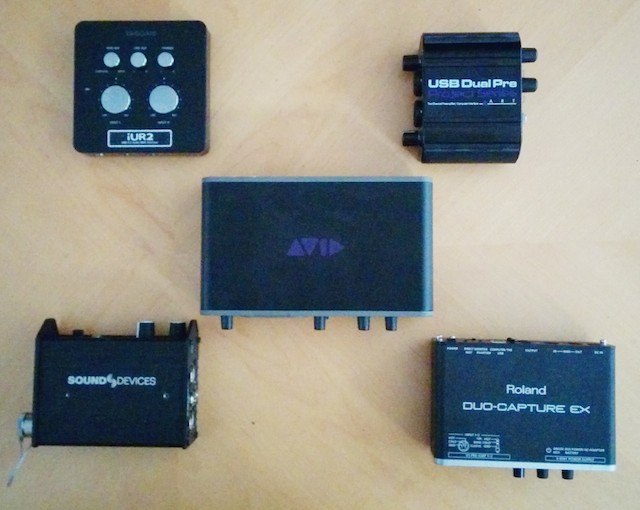
The above is an actual photo, taken to give you an idea of the relative sizes and shapes of the devices.
Ahead you’ll find a total of six tests. That’s because I made one test using the AT2005USB’s built-in preamp and A>D converter, just for your knowledge, even though it won’t help when connecting multiple mics to an iOS device. (At least as of today, I have never seen any device that accepts multiple USB mics to record on an iOS device.)
All of the test recordings were made with my 11″ 2013 MacBook Air (1.3 GHz Intel Core i5 with 8GB of RAM) since I didn’t have access to any iOS device for enough time to do all of these tests. However, all of the devices are proven to be iOS compatible by multiple reliable sources, and the only questionable one I did a test with my friend María’s iPad to confirm both compatibility and power requirement. In all cases, the AT2005USB microphone was mounted onto a Heil PL–2T overhead broadcast boom, at the same distance from my mouth, using an acoustic filter, and it sent its balanced analog signal from its XLR output. Here they are, in order of ascending street price, from US$79 to US$899.
ART USB Dual Pre…
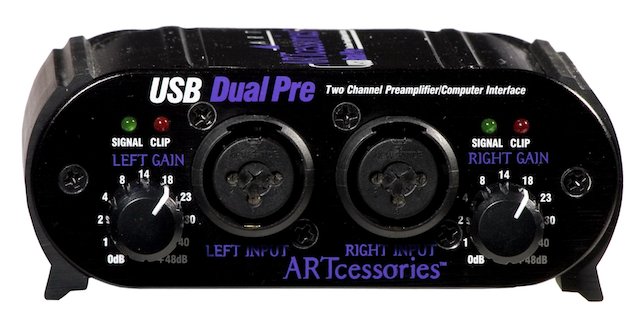
Number of balanced microphone inputs: 2
Level metering: Signal present and clip LED indicators
Dimensions: 44.5 x 117 x 119 mm (1.75 x 4.6 x 4.7 inches)
Weight: 0.59 kg (1.3 pounds)
How to connect to iOS device: With later iOS models, with Apple’s Lightning to female USB adapter . With older iOS models, the Apple Camera Connection, either together with the USB Dual Pre’s included USB cable.
Electrical power: USB bus power (from a traditional computer), 9-volt internal battery (ideal for use with iOS devices), or by an external 12-volt power supply (sold separately)
How many bit at 48 kHz: 16 bit
Approximate street price: US$79
Other comments: As you’ll notice in the main picture for this article and by its measurements, this is the most compact and lightest of all compared external interfaces. Although not marketed for it, there are people who have drilled holes into the USB Dual Pre and used it with traditional (non-iOS) cameras as a preamp as an alternative to those sold by Beachtek and JuicedLink.
Tascam iUR2…
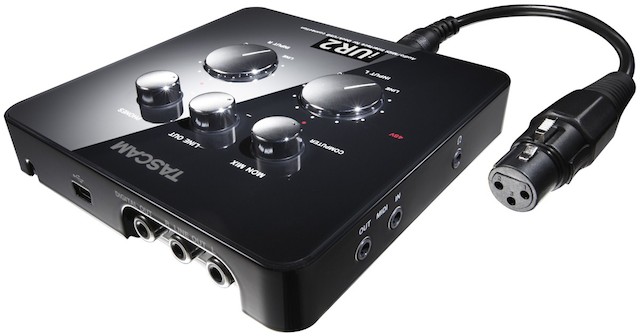
Number of balanced microphone inputs: 2 (TRS balanced 1/4“, including adapters to female XLR).
Level metering: Clip LED indicators
Dimensions: 110 mm x 20 mm x 110 mm (4.33 x 0.78 x 4.33 inches)
Weight: 220 g (0.48 pound)
How to connect to iOS device: With later iOS models, with Apple’s Lightning-to–30 pin adapter. With older iOS devices, with the iUR2’s own, always attached 30-pin cable.
Electrical power: USB bus power (from a traditional computer) or external USB power. According to my initial testing and research, the Tascam iUR2 was originally designed to take power from the 30-pin cable with iOS 6, but starting with iOS 7, no longer receives power through the 30-pin connector, and unfortunately requires external USB power even when connected to an iPad via 30-pin. I will update this if the situation changes.
How many bit at 48 kHz: 16 bit
Approximate street price: US$150
Other comments: I thank Tascam for including the adapters that go from female XLR to male TRS 1/4”, especially for initial use or “studio” (fixed) use. However, for a mobile rig, to reduce bulk, I’d instead use microphone cables that go directly from female XLR on one end to male 1/4″ TRS, like this one.
Roland Duo-Capture EX…
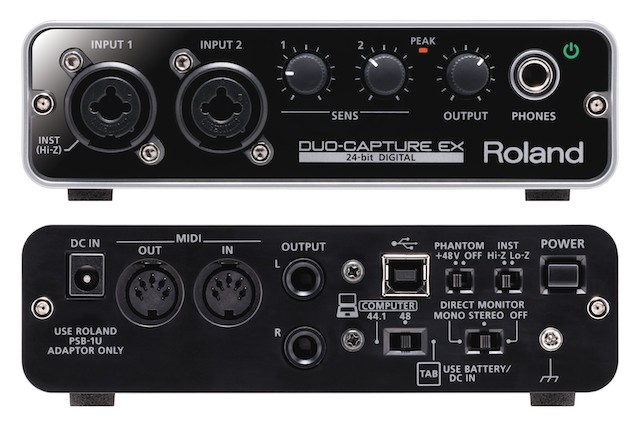
Number of balanced microphone inputs: 2
Level metering: Peak LED indicator
Dimensions: 153 x 119 x 460 mm (6–1/16 x 4–11/16 x 1–7/8 inches)
Weight: 460 g (17 ounces)
How to connect to iOS device: With later iOS models, with Apple’s Lightning to female USB adapter . With older iOS devices, the Apple Camera Connection Kit, either together with the included USB cable.
Electrical power: USB bus power (from a traditional computer) or internal AA batteries (ideal for use with iOS devices).
How many bit at 48 kHz: 24 bit (Can also do 44.1 kHz.)
Approximate street price: US$199
Other comments: I reviewed the Duo-Capture EX in August 2013.
Avid FastTrack Duo…
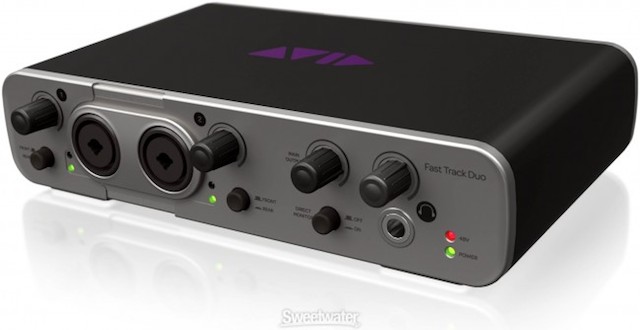
Number of balanced microphone inputs: 2
Level metering: Signal present (green) and clip (red) for each input
Dimensions: 205 x 140 x 50 mm (8.1 x 5.5 x 2 inches)
Weight: 0.8 kg (1.8 pounds)
How to connect to iOS device: With later iOS models, with Apple’s Lightning-to–30 pin adapter. With older iOS devices, with the FastTrack Duo’s own 30-pin cable.
Electrical power: USB bus power (from a traditional computer) or external USB power (required when using with an iOS device).
How many bit at 48 kHz: 24-bit
Approximate street price: US$249 (recently lowered from US$299)
Other comments: The largest and heaviest of the reviewed devices, the FastTrack Duo also includes Pro Tools Express software for Mac or Windows (not used for this article), which can also get purchasers a special discount on a full Pro Tools, if desired.
SoundDevices MixPre-D…
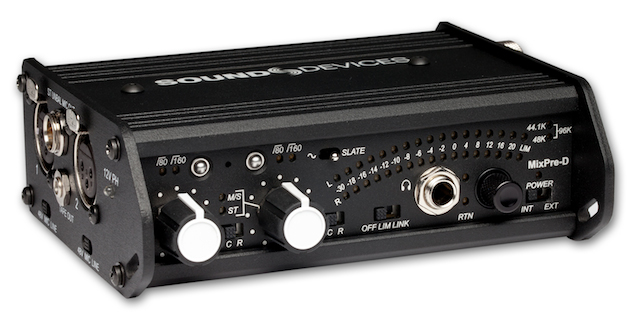
Number of balanced microphone inputs: 2
Level metering: Sunlight-viewable, 16-segment GaN LED output meter with adjustable brightness
Dimensions: 43 x 94 x 140 mm (1.7 x 3.7 x 5.5 inches)
Weight: 0.7 kg (1.5 pounds) with batteries
How to connect to iOS device: With later iOS models, with Apple’s Lightning to female USB adapter. With older iOS devices, the Apple Camera Connection Kit, either together with a standard USB cable.
Electrical power: Internal AA batteries (ideal for use with iOS devices) or external 10–18 VDC power supply (optional)
How many bit at 48 kHz: 24 bit (can also do 44.1 or 96 kHz)
Approximate street price: US$899
Other comments: The MixPre-D is also marketed by SoundDevices (with an optional tripod mount adaptor that they sent to me) to be used with traditional (non-iOS) video cameras, i.e. competing with devices like those made by Beachtek and JuicedLink. Exquisitely built like a tank or a Hummer, the MixPre-D features a long list of unique features, including: limiters, high-pass filters, slate tone, and input panning to Left, Center, or Right outputs. Regarding MixPre’s panning capability (which is unique among the tested devices in this article), I’ll be going into much more detail in an upcoming article, called Dealing with USB interfaces’ left/right challenge: Hardware & software solutions.
Enough gain for the dynamic microphone?
Originally, I planned to include the published available gain for each unit in this article. Then I noticed that many of the manufacturers don’t publish that spec, and some publish a spec “from minimum to maximum” spec, but that doesn’t help determine the maximum available gain, since the potentiometer is very likely to reduce the volume of the input signal when set to minimum. So I decided to leave that spec out of the article and just state that all of them except the MixPre-D required its potentiometer to be at absolute maximum position to get even a decent recording level (not even close to peaking or clipping), and all required a varying amount of boost during the normalization process in software (I used Fission version 1.6.12 to normalize the clips for the tests in this article). Compared to the others, the least amount of boost during normalization was required by the MixPre-D and the FastTrack Duo. If your application/project involves post-production (including a normalization step) anyway, then your perception of the final quality of each clip shouldn’t be affected by how much extra boost was required to reach the final normalized level. In other words, if you are happy with how the final sound clip sounded with any particular device, then that’s fine. However, if your application requires live transmission or streaming (without any post-production), then you are best served by having the highest acceptable output directly from the hardware device, either (a) by purchasing such a device with sufficient gain, or (b) by using a microphone which —when combined with the preamp and A>D converter— produces enough gain for live applications, or (c) by adding another device prior to it, like the Cloudlifter CL–1, which I have never tested personally, but has absolutely excellent (and seemly unanimous) reviews online.
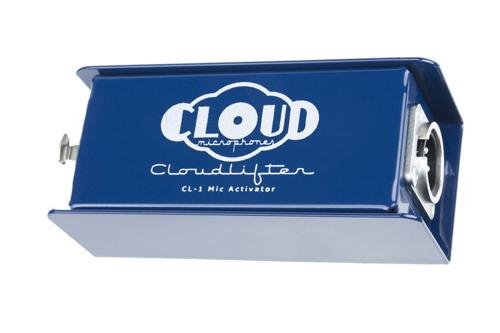
The Cloudlifter CL–1 is a device that is designed to pre-amplify dynamic microphones before another preamp, making the dynamic mic’s output to be much more like that of a condenser mic, by adding 25 dB in advance. The Cloudlifter CL–1 is powered —quite ironically— via phantom power, which all of these devices can provide to it, so adding one wouldn’t require any extra power connections (just more draw on your battery, like any phantom power setup does). Of course, the Cloudlifter doesn’t send the phantom power to the dynamic mic, it just uses it for its own amplification.
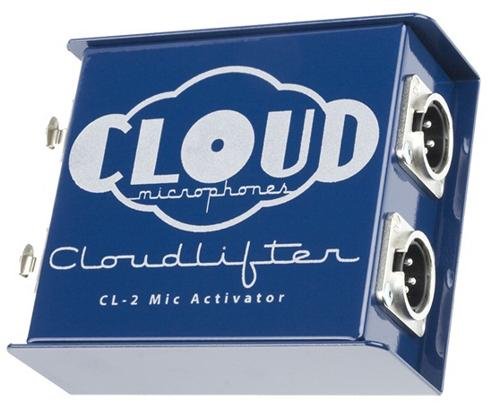
And if you were wondering, there is also a dual-channel version called the Cloudlifter CL–2 which handles 2 channels together. But that is only required if you are not satisfied with the final result after normalization, or if you have a live application.
Related articles
- iOS 7 expands digital USB audio use with iPhone/iPod Touch from January 7, 2014
- RØDE Rec audio app for iOS has come a long way from January 8, 2014
Upcoming articles, reviews, and books
Stand by for upcoming articles, reviews, and books. Sign up to my free mailing list by clicking here.
Si deseas suscribirte a mi lista en castellano, visita aquí. Si prefieres, puedes suscribirte a ambas listas (castellano e inglés).
My latest book (paperback + ebook)
My most recent book is available in two languages, and in paperback as well as an ebook. The ebook format is Kindle, but even if you don’t have a Kindle device, you can read Kindle books on many other devices using a free Kindle app. That includes iPad, Android tablets, Mac computers, and Windows computers. Although generally speaking, Kindle books are readable on smartphones like Androids and iPhones, I don’t recommend it for this particular book since it contains both color photos and color comparison charts. The ebook is also DRM-free.
In English:

In English, it is currently available in the following Amazon stores, depending upon your region:
- Amazon.com, for the US and other countries in the Americas that don’t currently have their own Amazon store, or anywhere if you simply prefer it
- Amazon.br for Brazil
- Amazon.ca for Canada
- Amazon.de for Germany
- Amazon.es for Spain pero a lo mejor lo preferirás en castellano, a continuación)
- Amazon.fr for France
- Amazon.in for India
- Amazon.it for Italy
- Amazon.co.jp for Japan
- Amazon.com.mx for México
- Amazon.co.uk for the United Kingdom
Or in your favorite bookstore by requesting ISBN–10: 1456310232 or ISBN–13: 978–1456310233.
En castellano:

En castellano, está disponible actualmente en las siguientes tiendas Amazon, según tu región:
- Amazon.com para EE.UU. y todas las Américas donde no existe ninguna tienda particular… o en cualquier parte si simplemente lo prefieres
- Amazon.com.br para Brasil
- Amazon.co.jp para Japón
- Amazon.de para Alemania
- Amazon.es para España
- Amazon.fr (Francia)
- Amazon.in para India
- Amazon.it para Italia
- Amazon.com.mx para México
- Amazon.co.uk para el Reino Unido
o en tu librería preferida al solicitar el ISBN–10: 1492783390 ó el ISBN–13: 978–1492783398.
Allan Tépper’s other books, consulting, articles, seminars & audio programs
Contact Allan Tépper for consulting, or find a full listing of his books, articles and upcoming seminars and webinars at AllanTepper.com. Listen to his TecnoTur program, which is now available both in Castilian (aka “Spanish”) and in English, free of charge. Search for TecnoTur in iTunes or visit TecnoTur.us for more information.
FTC disclosure
No manufacturer is specifically paying Allan Tépper or TecnoTur LLC to write this article or the mentioned books. Some of the other manufacturers listed above have contracted Tépper and/or TecnoTur LLC to carry out consulting and/or translations/localizations/transcreations. Many of the manufacturers listed above have sent Allan Tépper review units. So far, none of the manufacturers listed above is/are sponsors of the TecnoTur programs, although they are welcome to do so, and some are, may be (or may have been) sponsors of ProVideo Coalition magazine. Some links to third parties listed in this article and/or on this web page may indirectly benefit TecnoTur LLC via affiliate programs.
Copyright and use of this article
The articles contained in the TecnoTur channel in ProVideo Coalition magazine are copyright Allan Tépper/TecnoTur LLC, except where otherwise attributed. Unauthorized use is prohibited without prior approval, except for short quotes which link back to this page, which are encouraged!

Filmtools
Filmmakers go-to destination for pre-production, production & post production equipment!
Shop Now